| Home » Daynotes Home » Week of 30 June 2003 |
 |
Daynotes
Journal
Week of 30 June 2003 Latest Update : Sunday, 06 July 2003 13:02 -0400 |
 |
| Click Here to Subscribe | Buy PC Hardware in a Nutshell, 2nd Edition: | [Amazon] [Barnes & Noble] [Bookpool] | Visit Barbara's Journal Page |
Monday, 30 June 2003
[Last Week]
[Monday] [Tuesday] [Wednesday] [Thursday]
[Friday] [Saturday] [Sunday]
[Next Week]
[Daynotes Journal Forums] [HardwareGuys.com
Forums] [TechnoMayhem.com Forums]
7:27 - We're officially finished with the third edition of PC Hardware in a Nutshell. It goes to the printer 15 July, arrives in the warehouses 23 July, and arrives in bookstores 29 July.
If you want to pre-order a copy (or copies), you can do so from the following links:
- Amazon
- Barnes & Noble
- Bookpool
Note that I am providing these links only for the convenience of my readers. I have no association with any of these companies (including "affiliate" agreements), nor do I endorse these companies. (I would have put up a link for Amazon.com, but they don't have the third edition listed in their database. It was there a couple of weeks ago, but now it's gone.)
![]()
When choosing utility software, I generally prefer OSS to commercial products when there's a choice available. It's not so much that OSS software usually doesn't cost money (although that's certainly a nice feature). It's that I have a higher degree of trust in OSS, both in the sense that I trust OSS developers not to include nastiness such as DRM and proprietary data formats, and in the sense that I trust their software to be less buggy than closed-source software.
Over the weekend, I decided to look into software to wipe the slack space on my hard drives. I found many products, but two of them were highly recommended by users. The first, BCWipe, is standard OTS commercial software, although it is free for personal use. The second, Eraser, is OSS. So, in keeping with my inclinations, I downloaded and installed Eraser 5.6 on both my primary office system and my den system. I suppose it's foolish to load a utility that has the potential to entirely trash a system on my main systems rather than testing it on a disposable system first, but I do these stupid things because I'm stupid.
I started Eraser running on my office system, and then went into the den to install it on that system. Everything appeared to be running normally on the den system. There was no option to minimize Eraser, but I wanted to check some web sites, so I fired up Mozilla 1.3.1. The first hint that something was wrong was when I clicked over to Jerry Pournelle's View page. Mozilla displayed only the top of the page, Jerry's photograph and the page header. The rest of the page was blank. So I clicked the Reload icon, and Mozilla promptly blew up and brought up a bug reporting dialog.
That was very strange, so I killed the Mozilla icon in the system tray, verified with Task Manager that MOZILLA.EXE wasn't running, and restarted Mozilla. When it came up, it displayed my default page, which is the local copy of my links page. Only the very top of the page, my photograph and the header, was visible. When I clicked the Reload icon, Mozilla blew up once again. Hmmm.
At that point, I figured there must be some sort of conflict between Mozilla and Eraser, so I fired up Internet Explorer. Same deal. It displayed only the very top of web pages. At least IE didn't crash and burn, although nothing I could do caused it to display the actual contents of web pages. I did a View Source, and all of the page source was present. It just wasn't rendering. So I fired up Cartes du Ciel, a planetarium program I use, and found that it displayed abnormally as well. CdC uses a bunch of icons along the left and right borders to give users quick access to various program functions. Most, but not all, of those icons were missing. Moving my mouse cursor to the place the icons should have been displayed caused a blank icon to be displayed momentarily, but as soon as I moved the mouse the icon disappeared. Clicking on one of the blank icons brought up the expected function dialog, although those too were missing many of their display elements.
At that point, I decided that something in Eraser 5.6 was fundamentally incompatible with Windows 2000, so I stopped the program using its Stop icon. It took a few moments to finish what it was doing and then exited normally. I checked Task Manager to verify that it hadn't left any background processes running. Once I was sure that Eraser was completely gone from the task list, I fired up Mozilla. Same thing. IE. Same thing. Cartes du Ciel. Same thing.
Keeping my fingers crossed, I rebooted the system, hoping that Eraser hadn't seriously damaged the system. After logging back on, I found that Eraser had installed a startup item that put an icon in the system tray. I killed that, used SpyBot Search & Destroy to examine the list of startup items, removed Eraser from that list, and again rebooted. After logging back on, I started Mozilla, which ran normally. So did Cartes du Ciel and the other applications I tried. So it appears that a reboot solved the problem, thank goodness.
Yesterday morning, I sat down at my office system. When I moved the mouse to unblank the screen, an Eraser dialog was sitting in the middle of my screen, telling me that it had completed the wipe normally. I fired up Mozilla, and found that it displayed only the top of web pages. Cartes du Ciel was borked, as was IE. In every respect, my office system was behaving just like my den system had been. I again exited Eraser, checked Task Manager for any background processes, and once I was sure Eraser was completely inactive, fired up Mozilla. Same problem. So I rebooted, forgetting about the Eraser startup item. I exited that, and ran Control Panel -> Add & remove software to uninstall Eraser. After a reboot, my system again behaved normally.
So in this case, my preference for OSS ended up causing me a lot of trouble. Eraser 5.6 is definitely not ready for prime time. I used it only under Windows 2000 SP2, so the problem may be specific to my configuration. But I sure wouldn't trust it under any version of Windows.
![]()
I spent some time Saturday and Sunday helping my friend Steve Childers work the new 17.5" truss-tube Dobsonian telescope he's building. Right now, Steve is trying to figure out how long to make the truss tubes that join the lower part of the scope assembly to the upper part. The mirror has a focal length of 87 inches (~ 2.2 metres), and we want the focal point at infinity to fall as exactly as possible mid-way in the focuser travel, which is only a couple inches.
The trick is to get the truss tubes cut such that they're short enough, but not too short. If they're a bit too long, the scope will be able to focus on things close to it, but not at infinity. If the truss tubes are too short, the scope won't be able to come to focus on anything. Too long, we can deal with just by cutting off a bit more. Too short is a disaster, because Steve would need to get new tubes and start over. They're not stock items locally, so he'd have to order them in, which would take a month or so. Mars is at closest approach in late August, and we need some time to get the kinks worked out, so cutting them too short is not an option. Accordingly, we're using the cut-and-try method, approaching the proper length slowly.
Here are some photos I took yesterday.
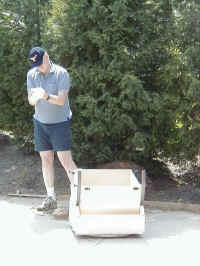
The ground board, rocker box, and mirror box in place.
Steve is putting on rubber gloves to make sure he doesn't get sweat and
fingerprints on the 17.5" mirror. This assembly is physically complete, but
Steve hasn't yet done the finish work on it. He'll sand it, stain it, and apply
several coats of exterior-grade polyurethane. When he's finished, it'll have a
furniture-grade finish. The plywood itself is very expensive Baltic Birch, which
has ideal physical characteristics for a truss-tube Dobsonian telescope, and is
also perfect visually.
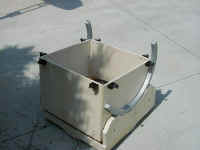
A closer view of the ground board, rocker box, and mirror
box. The ground board is the part nearest the ground. It rests on feet that
Steve made from hockey pucks. The low-profile box above the ground board is the
rocker box. It's secured to the ground board by a bolt that merely keeps the two
from separating. The ground board has Teflon pads facing up. The rocker box
bottom is covered in Ebony Star, a nubby laminate. The friction
characteristics of those two materials are perfect for a Dobsonian telescope,
which must have enough friction to stay in place, but not enough to make it
difficult to move smoothly. The Teflon pads and Ebony Star laminate on the
rocker box and ground board are the azimuth bearings (right-to-left motion). The
large semi-circular things on the side are cast aluminum altitude hubs (up-down
movement). Those hubs are covered with Ebony Star laminate, and ride on Teflon
pads on the semi-circular cutouts in the rocker box.
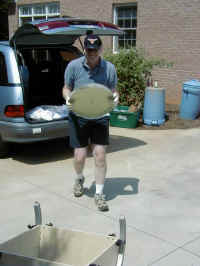
Steve carrying the 17.5" mirror from its temporary
home in the back of his van. That's an expensive piece of glass, about $1,700
worth. Steve chose a primary mirror from Discovery Telescopes. Their
"premium" models are actually semi-premium in real terms. A 17.5"
mirror from a true premium mirror maker like Carl Zambuto or Robert Royce might
cost twice that much. A Discovery premium mirror provides about 95% of the
performance at about 50% of the cost. I think Steve made an excellent decision
going with the Discovery.
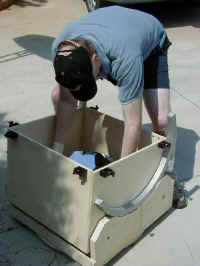
Steve lowering the 17.5" primary mirror carefully
into the mirror box, where it is supported by an AstroSystems mirror cell. Once
the scope is finished, the mirror will remain in the mirror cell permanently,
but while we're working on it we keep the mirror in a safe location while we're
doing things that might cause something to be dropped onto the mirror surface.
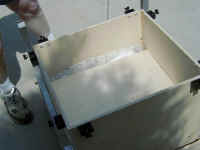
We're about to mount the truss poles for the first time.
Just to be safe, Steve puts a layer of tissue paper on top of the primary
mirror. We need the mirror installed for testing, but we don't want to drop
anything onto it while we're learning to assemble the truss. Steve puts some
bubble-wrap on top of the tissue paper, and finally lays a sheet of plywood on
top. If we drop a tube or something, it won't be able to hit the primary mirror.
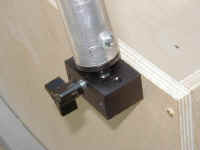
Here's a close-up of the ball-and-socket mount for a truss
tube. The ball portion is permanently inserted into the truss tube. The knob on
the side of the assembly locks the ball into the socket. With this arrangement,
it takes only a couple of minutes to make the 16 connections needed to connect
all eight truss tubes at both ends.
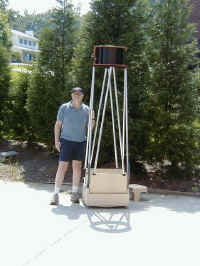
This gives you some idea of the scale of a big Dob. Steve
is 6'4" tall. The truss tubes are still a bit too long to let the scope
come to focus. (Better too long than too short at this stage. It's easy enough
to shorten the truss tubs, but not at all easy to lengthen them.)
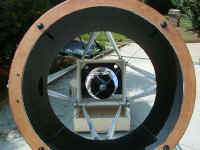
I shot this looking straight down the scope toward the
primary mirror. The black thing in the middle is the secondary holder. The thin
wires are the supports for the secondary holder. Anything in the light path
(including the secondary) causes diffraction, which is a Bad Thing. The thinner
the secondary support vanes can be and still support the secondary rigidly, the
better. This is a premium secondary holder from AstroSystems. It has a premium
secondary mirror (not visible here, because it faces the primary).
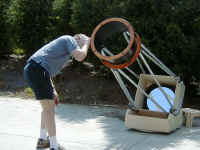
Steve checking out the focus. As it turned out, the truss
tubes were much too long, possibly as much as 6" or 7". We had planned
to check focus on a nearby object (the closer the object, the more the out-focus
is required). We'd hoped to be able to focus on an object 50 to 100 feet away.
If we could have done that, we could have judged mathematically how much long
the tubes were. Ideally, Steve wants the infinity focus point to fall about
halfway between the extremes of the movement of his focuser. The tubes were just
too long, though. We even tried focusing on the bushes behind the scope, which
were perhaps six feet from the front of the scope. We couldn't even come to
focus on them. I was a bit concerned that the primary collimation was off badly
enough that the light cone from the primary was missing the secondary
altogether. Upon thinking about it, though, we decided that if primary
collimation was that far off it didn't really matter. That would still mean that
the tubes were several inches too long. So Steve decided to cut 4" off the
tubes last night and try again later.
![]()
11:44 - The Inquirer ran an interesting article this morning about AMD missing its deadline for delivering the Opteron at 2.0 GHz. That's not news in itself. AMD has missed so many Opteron deadlines that that processor is called the Lateron by many. The interesting part was Intel's competitive response to the Opteron. Although Intel sells small-cache Xeons running at high clock speeds, they've limited the large-cache Xeons to 2.0 GHz. Why? There was no need to produce faster versions, and doing so would simply leave money on the table. But faced with competition from a 2.0 GHz Opteron, the large-cache Xeons couldn't have kept up. The Xeon has a much deeper pipeline than the Opteron, which means the Opteron can perform more instructions per clock. Clock-for-clock, the Opteron would kill the large-cache Xeons.
So what does Intel do? They announce, "Oh, by the way. We're going to start shipping large-cache Xeons at 2.8 GHz." Smack! Take that, Opteron. A 40% increase in clock speed overnight, while AMD strains for each additional MHz with the Opteron. Talk about a shot across the bow. No one I know who knows anything about Intel processors seriously believes that Intel couldn't ship a 3.2 or 3.4 GHz large-cache Xeon any time they want to. And that's with the 0.13µ Xeon core. Intel still has the 0.09µ core waiting in the wings. I'd expect them to introduce those processors at 3.4 to 3.6 GHz, and they should scale to 5 GHz or higher. No matter how much clock speed AMD is able to eke out of the Opteron core, Intel can simply smash down their ace of trumps and put Opteron back in its place.
Opteron's claim to fame, of course, is its ability to execute both 32-bit and 64-bit instructions simultaneously. Not that there's much 64-bit software available right now to take advantage of that. SuSE has a 64-bit Linux distro, and Microsoft has promised 64-bit Windows for the Opteron Real Soon Now. But even if gobs of 64-bit software were available now, I wonder just how important 64-bitness is to most people. Sure, there are a few that need 64-bit operations and/or the additional memory addressability that the Opteron provides. But I can't see 64-bit processing becoming a desktop must-have any time soon.
Even if it does, Intel may have a nasty surprise in store for AMD. Speculation has it that the new 0.09µ Intel core has Yamhill as a hidden feature. Just as Intel put Hyper-Threading Technology support on the Northwood core where it remained hidden until Intel chose to reveal it, I think Intel has their 64-bit Yamhill technology built into the new core, where it will remain hidden until Intel thinks it's time to trot it out (if ever). Clearly, Intel would prefer to keep the desktop 32-bit for now and convince those who really need 64-bit operations, e.g., datacenters, to go with Intel's native 64-bit processors. But if Opteron (and hybrid 32/64-bit computing) becomes a big hit, Intel will have the Yamhill ace up its sleeve.
Again, this is all speculation on my part, but if it happens don't be surprised.
![]()
I kept track of overnight spam for the month of June. (In other words, I just did counts the first time I logged in each morning; I didn't bother to count spams during the working day, which is when most of my message traffic, including spam, occurs.
For the month of June, my overnight message traffic was 37.9% spam. Of those spams, SpamAssassin caught 97.9%.
In a personal sense, spam isn't much problem for me now. I can deal with those few messages that SpamAssassin misses in just a few seconds a day. In a larger sense, of course, spam remains a huge problem because it clogs the arteries of the entire email system. Even those spams that SpamAssassin dealt with for me still took up bandwidth getting from their source to my mail server, and running SpamAssassin itself consumes processor ticks that could otherwise have been used for something useful. But I'll take what I can get, and not having to spend much time dealing with spam myself is definitely good.
![]()
I have a problem. When I installed Mozilla for Barbara, I imported all her Outlook mail and made Mozilla Mail the default mail client. I disabled mail functions in Outlook, and told Barbara she could continue using Outlook as her PIM. That worked fine except for one thing. Barbara can no longer synchronize her Sony PDA (Palm-OS). The first time she tried to sync, a dialog popped up to tell her that she couldn't sync because Outlook wasn't her default mail client. That seemed easy enough to fix. I made Outlook the default mail client and tried to sync again. The HotSync software delivered another error message (I forget exactly what it said) and again refused to sync.
Barbara just emailed me to say that she needs to change batteries in her PDA and wants to sync this evening. What I'd like to do is get her data from her PDA onto her desktop PC in the Palm Desktop application, rather than in Outlook. Is there any way to do that, short of manually re-entering everything? If you have any ideas, please let me know over on the messageboard.
[Top]
Tuesday, 1 July 2003
[Last Week]
[Monday] [Tuesday] [Wednesday]
[Thursday] [Friday] [Saturday]
[Sunday] [Next Week]
[Daynotes Journal Forums] [HardwareGuys.com
Forums] [TechnoMayhem.com Forums]
10:35 - Barbara's PDA synching problem is solved. The following is a message that I posted to the messageboard yesterday. (There are several posts over on the messageboard in this week's topic that are worth reading and filing away or bookmarking if you ever need to worry about synch status of a PDA and Outlook. Stuff like using Linux to make a backup of the PDA's data before attempting the Windows synch, and so on.)
Thanks to everyone. Barbara's PDA is now synched, and the reason it wasn't is embarrassing.
I'd noticed that Barbara's machine had slowed down recently, and by a lot. I fired up SiSoft Sandra today and checked stuff like CPU, memory, and hard drive benchmarks. Everything looked reasonable, allowing of course for the fact that this is an old system with a Pentium 3/1.0G processor.
I was so sure that I had installed 256 MB in there that I didn't even bother to look. But the hard drive just kept thrashing for no reason, which told me it was paging. Finally, I clicked Task Manager. Ulp. Only 128 MB of RAM. Arrrghhh. No wonder it was thrashing. I'd be thrashing, too.
So when Barbara got home this afternoon she started cleaning house. I disconnected her PC and carried it into the kitchen to open up and clean out. (There was enough fur and dust in there to pave a large rat, and perhaps even a small cat.) When I could finally see what was in there, I noticed that there was one 128 MB Kingston PC133 DIMM. Ughh.
So I went off to my storage shelves in search of PC133 memory. The first box I came across had a Crucial 128 MB CL2 DIMM and a Crucial 512 MB CL3 ECC DIMM. I remembered that the D815EEA2 board she has supports only 512 MB max, but I thought I remembered something about compatibility issues with 512 MB DIMMs. I checked the Crucial memory configurator, and sure enough that board supports only 256 MB DIMMs max.
I was going to search some more for some 256 MB PC133 DIMMs (I'm sure I must have a few around here somewhere), but I decided that 256 MB really was enough, especially since this won't be Barbara's system much longer. The new one I'm building her has a Pentium 4/2.8C and 1 GB of PC3200.
I installed the additional 128 MB, reconnected the system, and fired it up. It runs much, much faster. I guess what had happened was memory creep. The system used to run fine, but as we've added resident stuff like AVG AntiVirus, WebWasher, etc. etc. the system just ran out of physical memory.
The kicker is that I decided to try running HotSync (actually, IntelliSync Lite) against Barbara's PST file. That had failed the last couple of times we tried. This time, it synched normally. I guess it just needed more memory.
The moral here is that one should never trust one's memory. I suspect insufficient memory early on, but I told myself that there was no way 256 MB wasn't enough for what Barbara does with her system. I was so convinced that there was 256 MB in there that I didn't bother to look until much too late in the process. Even once I had the 128 MB number staring me in the face, I still wasn't convinced that I hadn't installed 256 MB. I thought a DIMM must have failed and "disappeared" as far as the system was concerned, or perhaps literally fallen out of the DIMM socket. When I opened that system and saw that there was only one 128 MB DIMM installed, I was so flabbergasted that I picked up the system unit and shook it, expecting another 128 MB DIMM to fall out from under the disk drives or something.
![]()
So Barbara is working for now. But yet another hardware problem has reared its ugly head. At least I think it's a hardware problem. Every Sunday, I do a backup of Barbara's and my systems to DDS3 tape. The tape drive is in my office system. I think it's an old Tecmar drive, but it may be an old Seagate drive. At any rate, the weekend before last I started the backup as usual. When I came back hours later, the backup app had popped up a dialog during verify, something about a data error reading the tape.
Fair enough. That tape had been in use for quite a while, so I looked around for a replacement tape. I didn't have any new ones readily at hand, but I did find a stack of older DDS3 tapes that had last been used a couple of years ago. I popped one of those in the drive, started the backup/verify again, and went away. When I came back, the backup app had again popped up a dialog about a data error. Hmmmm. That didn't look good, but I was too busy to do anything about it at the moment, and I'm backed up many other ways anyway.
So this past Sunday, I again ran a cleaning tape through the drive, stuck in tape Weekly 2, and started the backup. When I came back a few hours later, that damned dialog was on the screen again. Data error. I think the drive itself may have problems. I was going to swap out the drive for another Seagate DDS3 or DDS4 drive, but this won't be my main system for too much longer, so I'll just let it go for now. I have DDS3 and Travan NS20 drives in other systems around here, so getting a backup done isn't a problem.
I think what I'll do is install a Plextor PX504A DVD+R/RW writer in my new main system and leave out the tape drive. I'll still have other tape drives for full backups, but I'd like to start using DVD+R/RW for routine backups on my main system. I checked the Best Buy web site last night, and found that I can get a spindle of 15 Verbatim DVD+RW discs for $50 or a spindle of 15 Verbatim DVD+R discs for $30. On a per-byte-stored basis, that about matches CD-R/RW media costs. At $2 each for DVD+R, that's the same as $0.30 each for CD-R discs. At $3.33 each for DVD+RW, that's the same as $0.50 each for CD-RW discs. (Incidentally, Verbatim DVD-R/RW discs were exactly the same price as Verbatim DVD+R/RW discs, which makes -R/RW pretty much obsolete.)
Two or three bucks each is certainly a reasonable price for backup/archive media. My only remaining concern with using optical for backing up and archiving is the much higher unrecoverable bit error rate. Tape drives have unrecoverable bit error rates of 10e-15 to 10e-19. Optical drives have unrecoverable bit error rates from ten to 1,000,000 times higher than that. Of course, the simple solution is to make two copies on optical disc. If one has an unrecoverable error, that file will almost certainly be readable on the second copy.
A 4.7 GB media should be sufficient for most people. It's not for me, but nor is it a big deal. I have tens of gigabytes of data, but a lot of it is actually archive data. I can back it up once (twice or thrice for redundancy) to DVD+R discs and have done with it.
![]()
10:40 - I've used and recommended PowerQuest PartitionMagic for years. Alas, I will have to take PowerQuest products off my recommended list. Someone on the HardwareGuys.com messageboard just posted a message saying that PartitionMagic now uses product activation. I checked the link in that message, and indeed PartitionMagic now requires activation before you can use it. I regard product activation of any sort as simply unacceptable. I refuse to buy or recommend any product from a company that treats its customers as thieves. Period.
![]()
11:41 - I just checked out my web stats for last month. For visitors to this site, here are the top 25 domains:
1 Network
2 US Commercial
3 Unresolved/Unknown
4 US Educational
5 Canada
6 United Kingdom
7 Non-Profit Organization
8 US Military
9 US Government
10 Australia
11 Mexico
12 Italy
13 Netherlands
14 Switzerland
15 France
16 New Zealand (Aotearoa)
17 Belgium
18 United States
19 Denmark
20 Brazil
21 Tuvalu
22 Germany
23 Portugal
24 Ireland
25 Sweden
To be honest, until I looked it up I wasn't sure where Tuvalu is. Having looked it up, I'm still not entirely sure. I assume that it was visitors from the .tv domain rather than visitors specifically from Tuvalu itself that bumped Tuvalu up to #21 for the month.
![]()
14:57 - I'm updating the HardwareGuys.com web site, and just noticed that Hitachi has discontinued all of their DVD-RAM products. I'm beginning to see a pattern here. DVD-RAM is moribund. DVD-R/RW is not much better off, with Pioneer, its strongest advocate, now producing DVD+R/RW drives. It looks to me more and more as though the long-standing writable DVD format war is over, and DVD+R/RW won.
[Top]
Wednesday, 2 July 2003
[Last Week]
[Monday] [Tuesday]
[Wednesday] [Thursday] [Friday] [Saturday]
[Sunday] [Next Week]
[Daynotes Journal Forums] [HardwareGuys.com
Forums] [TechnoMayhem.com Forums]
11:56 - We're back into monsoon season here. We had a couple of weeks where it rained only a few times, but now it looks like we're back to rain all day long every day. Barbara couldn't believe it the other day when she noticed that her grass had turned brown. I told her it had probably drowned. The poor dogs are disgusted. They go out and sniff around desperately looking for scents that have all been washed away. And our telescopes are gathering dust. Ordinarily, this is a good time of year for observing, but for the last several months we've had very few nights when there was anything other than clouds to look at. I blame it on the Kyoto Treaty.
![]()
With the third edition of PC Hardware in a Nutshell just about put to bed, I'm looking around for a new project. Brian Jepson, my new editor at O'Reilly, picked up on a comment about a book I'd like to do that I'd made to Laurie Petrycki at O'Reilly's Cambridge office. Brian seems excited about doing that book. On the other hand, I talked this morning with another O'Reilly editor about another book I'd first discussed six months or more ago with Robert Denn, my former editor at O'Reilly. So, I could end up doing one or the other of those books, both, or neither. And there are a couple of other projects that have been on the back burner that I mean to pay some attention to, including a possible new series I'd like to pitch to Tim O'Reilly. Sorry for being so vague, but publishers hate having ideas become public before they're well on the way to fruition.
I think I'm going to be a busy author for the rest of this year.
[Top]
Thursday, 3 July 2003
[Last Week]
[Monday] [Tuesday]
[Wednesday] [Thursday] [Friday] [Saturday]
[Sunday] [Next Week]
[Daynotes Journal Forums] [HardwareGuys.com
Forums] [TechnoMayhem.com Forums]
10:05 - Roland Dobbins sends the following warning:
-------- Original Message --------
Subject: Heads up for 6Jul03
Date: Wed, 2 Jul 2003 12:32:06 -0700
From: Roland Dobbins
To: Jerry Pounrelle, Robert Bruce Thompson, Brian Bilbrey, Greg Lincoln, Tom SyroidPlease disseminate far and wide, taking appropriate preparatory actions, thanks!
http://www.defacers-challenge.com/defeng.htm
and
and
-------- Original Message --------
Subject: Zone-H statement on defacement contest
Date: Wed, 2 Jul 2003 21:53:38 -0700
From: Roland Dobbins
To: Jerry Pounrelle, Robert Bruce Thompson, Brian Bilbrey, Greg Lincoln
And some other mail that I'm just getting around to but should have posted earlier...
-------- Original Message --------
Subject: Interesting Ahead Nero Burning ROM/InCD update
Date: Tue, 1 Jul 2003 14:37:50 -0600
From: Ron Morse
To: Robert Bruce Thompson, Jerry PournelleJerry, Robert:
Both of you have mentioned Nero Burning ROM in the past and I wanted to let you know that Ahead has released a point update to Nero Burning ROM (5.5.10.42) and an interesting update to the companion UDF writer, InCD, which has evolved from version 3.X to 4.0.1.7.
Ahead claims version 4 uses a completely new engine. Supposed to be fully MMC compliant (and warns that older drives may not provide the info required to configure it properly).
I just installed it and can report it is significantly faster than the old version, but I don't know if it still gets confused moving big files as it used to. It moved 13mb of updates off the scratch partition where downloads go to the Plextor 24/10/40a without a hitch.
Both updates are free of charge to registered users of Nero Burning Rom.
www.nero.com for their version.
Regards and best to all
Ron Morse Captain, U.S. Navy (ret)
Thanks. I confess that I seldom use packet-writing other than for the book. Usually, I just use Nero to select directories/files to be backed up and burn them to CD or DVD. I may start using packet-writing more once Windows and Linux implement Mt. Rainier. At that point, the optical drive will appear to the OS and applications as just another writable drive. Until then, I'll probably stick with pre-mastering. Nero's InCD works a lot better for me than Adaptec/Roxio DirectCD did, but packet-writing software as a class has always been problematic.
-------- Original Message --------
Subject: Once again...
Date: Wed, 2 Jul 2003 08:53:34 -0400
From: Scott Kitterman
To: Bob Thompsonhttp://www.washingtonpost.com/wp-dyn/articles/A60817-2003Jul1.html
Yes, I'm still surprised that so many people have signed up for Microsoft's Passport. There are two separate concerns here: trusting Microsoft with your data, and trusting Microsoft with your data. The first in the sense of who knows what they'll do with it by accident, and the second in the sense of who knows what they'll do with it on purpose. I don't have, never have had, and never will have a Microsoft Passport. Or at least if I do it will only be because I must have it to access something for book writing purposes. I'll not give them any real information I can avoid giving them, and I'll not use Passport for anything except the very limited purpose for which I got it in the first place. I think anyone who uses Passport routinely is just asking for trouble.
And Bo Leuf comments on Athlon versus P4.
-------- Original Message --------
Subject: AMD and Pentium
Date: Thu, 03 Jul 2003 12:38:39 +0000
From: Bo Leuf
To: Robert Bruce ThompsonAll other things being roughly equal, I've noticed a user-perceptible difference between an AMD-based and a P4 system. When browsing, the AMD system has more distinct and longer delays rendering jpg images, and second-long delays when clearing cache to make space for new content. These processing delays adversely affect anything else running, so for instance a playing mp3 is interrupted for the duration of render/clear. Something to do with poorer thread support in AMD?
My observations concern primarily a desktop system AMD Athlon 1.4GHz vs a P4 mobility 1.6/1.2 GHz (depending on how it is powered). Even at 1.2GHz, the P4 won't so much as give an mp3 'hic' in most cases.
Yes, the Pentium 4 is certainly superior in most graphics/multimedia applications. If you're running SSE2-enabled applications, the P4 often beats the Athlon badly even clock-for-clock, let alone using AMD's QuantiSpeed performance ratings. On the other hand, the Athlon often does quite well in standard business apps.
![]()
Busy day on the book front yesterday. Several ongoing discussions with editors about possible books, and Sarah Sherman (the production editor for PCHiaN) sent me the index, which I have to look over, correct if necessary, and send back by 5:00 p.m. today.
![]()
Yesterday, Pournelle posted an interesting essay by Greg Cochran, entitled How the Ashkenazi Got Their Smarts. It's long been known that Ashkenazi Jews average roughly one standard deviation smarter than whites of European heritage. That is to say that while the IQ bell curve for European whites centers on 100, for Ashkenazi Jews it is skewed a full standard deviation to the right, centering on about 115. That fact isn't in question. What remains a matter of hot debate is why this is true. I think Cochran nailed it. At least, his is the most convincing explanation I've yet seen.
![]()
We may head up to Bullington to observe tonight. The forecast is semi-promising. Luna is only 0.13 illuminated, and will be low in the sky. It sets at about 23:50. The real question is transparency, which may not be great. The good news is that Marsrise is just before midnight, and Mars will be high enough to observe by 01:30 or 02:00. Last time, Mars was obscured by a planet-wide dust storm pretty much the whole time it was within reasonable range of amateur instruments. This time, there wasn't expected to be a dust storm, but the latest news is that there's a dust cloud. We hope it dies down rather than turning into a planet-wide dust storm, but we may have to get our observing in while we can still see some surface detail. Mars is currently about 17.2 arcseconds in apparent size. In late August, it will be closer to Earth than at any time in the past 58,000 years, and will have an apparent size of about 25 arcseconds. But that extra size won't do us much good if the surface is obscured by dust storms.
12:31 - The Inquirer has an interesting article about why you might not want to buy a used notebook computer. Although the article is UK-specific, the problem they mention exists in the US as well. With new entry-level notebook systems starting at less than $750, it's all too easy to end up spending too much for an older, slower, used notebook system. In particular, the battery is always a concern. The battery in a used notebook may be fine, but more likely it's teetering on the edge. And, if you've priced replacement notebook batteries lately, you know that buying a new battery can cost a significant fraction of the price of a used notebook. That's if you can even find one at all.
With a new notebook, even an entry-level model, you get a faster system, current software, a known-good battery, and a warranty. That $750 currently buys you a 2.0 GHz Celeron processor, 256 MB of memory, a 56K modem and 100BaseT network adapter, a 14.1" display, a 30 GB hard drive, and a DVD-ROM drive. For an extra $100 or so, you can add a spare battery. Compare that to prices I've seen on Pentium III (or even Pentium II) notebooks with half or less the processor speed, memory, and hard drive size, not to mention an inferior display, a CD-ROM drive if you're lucky, and a questionable battery. It's a no-brainer. I wouldn't pay more than $200 to $300 for any used notebook system other than a very recent high-end system from IBM or one of the other name-brand notebook makers. When I checked bids on older notebook systems on eBay, I was shocked at the high prices people were paying for what amounted to obsolete notebook systems. And they think they're getting a deal.
[Top]
Friday, 4 July 2003
[Last Week]
[Monday] [Tuesday]
[Wednesday] [Thursday] [Friday]
[Saturday] [Sunday] [Next
Week]
[Daynotes Journal Forums] [HardwareGuys.com
Forums] [TechnoMayhem.com Forums]
Happy Birthday USA!
9:32 - Barbara and I went up to Bullington last night to observe. Steve Childers and Paul Jones also came. The weather forecasts were not perfect, but it was possible that we'd have clear weather so we elected to take a chance and drive up. Alas we were disappointed. There was a heavy haze, so heavy that it made it impossible to see what would normally have been naked-eye objects. The humidity was well above 80%, which meant that all of our equipment was soon dripping with dew.
The last straw was when we watched an Iridium flare, which occurred at 23:01 and some seconds at azimuth 263 and altitude 15. The actual magnitude from our location was -6, which is extraordinarily bright. What we actually saw was, we all agreed, about magnitude -2. That meant that the haze at 15 degrees elevation had decreased the apparent brightness by four full magnitudes. In other words, a first magnitude (bright) star at 15 degrees elevation would appear to us as fifth magnitude (almost invisible to the naked eye). Ugh. It was clearer nearer the zenith, but not enough so to make viewing very pleasant.
Between the dew and the haze, we all decide to pack up. We got out of there by 11:30 and home by midnight. We were hoping for better skies, because this will be our last opportunity for a while. Luna is waxing, which means we'll soon have a bright moon ruining viewing. This has not been the best year for observing. As a matter of fact, it's been the worst in living memory. Oh, well.
[Top]
Saturday, 5 July 2003
[Last Week]
[Monday] [Tuesday]
[Wednesday] [Thursday] [Friday]
[Saturday] [Sunday] [Next Week]
[Daynotes Journal Forums] [HardwareGuys.com
Forums] [TechnoMayhem.com Forums]
9:05 - I worked all day yesterday on new system configurations and updating the HardwareGuys.com web site.
Killed another rat, too. I was working on my den system and got up to go into the kitchen for a Coke. My foot tangled in the mouse cord and I pulled it off the top of the case and onto the hardware floor, where it lay on its back stunned senseless. When I picked it up, it didn't rattle, but neither did it work. I replaced it with a Microsoft cordless unit. It seems strange to have no mouse cord, but it works fine. This was a unit I had sitting on the shelf from previous testing. It already had batteries installed.
The unit I'm using is a ball mouse rather than an optical. With the ball mouse the batteries seem to last forever. I'd guess that it shuts its transmitter off instantly when it's not needed, so even when I'm using the mouse to work normally it's probably turned off 99% of the time. Although I've used optical cordless mice, I'm always concerned about battery life, because rather than just powering a very small RF transmitter an optical mouse also has to power the LED. Certainly an LED is relatively low draw, but I'd guess an optical cordless mouse being used full time will need the batteries changed every couple of months, while the standard cordless mouse seems to use one set of batteries forever.
We expected last night to be rough on the dogs, and it was. They really, really don't like fireworks. The ones that just make a big boom are bad enough, but the ones that whistle or make staccato pops are even worse. Barbara went back to bed early, and when I went back I found her lying on the bed with a dog stretched out on either side of her. I should have known better, but I sat down on the edge of the bed to pet Malcolm, who was nearest me. He immediately got up and went over to confront Duncan (Malcolm regards Duncan as a vicious biter, which he is when it comes to Malcolm) and to protect me from Duncan. They got into it, snarling and with fangs flashing, all of this on top of Barbara, who was shouting, "Get them off me!" I got them separated and off to their respective corners, but Duncan turned around and went after Malcolm again. Duncan is a pretty gentle dog, and he hates to get into a fight. But once a fight starts, he's determined to end it.
![]()
The Pompous Git takes exception to Bo Leuf's comments about jerky MP3 playback on AMD systems.
-------- Original Message --------
Subject: AMD hiccups playing MP3s
Date: Fri, 4 Jul 2003 09:28:52 +1000
From: Pompous Git
To: Bo Leuf, Robert Bruce ThompsonI have tried to reproduce the problem Bo reports on my 700 MHz AMD K7/WinXP SP1 without success. No P4 to compare with yet, but that's only a matter of time.
I did discover that IE can't display a 8.93 MB JPEG with CMYK colour space, though!
---------------------------------
"All other things being roughly equal, I've noticed a user-perceptible difference between an AMD-based and a P4 system. When browsing, the AMD system has more distinct and longer delays rendering jpg images, and second-long delays when clearing cache to make space for new content. These processing delays adversely affect anything else running, so for instance a playing mp3 is interrupted for the duration of render/clear. Something to do with poorer thread support in AMD?My observations concern primarily a desktop system AMD Athlon 1.4GHz vs a P4 mobility 1.6/1.2 GHz (depending on how it is powered). Even at 1.2GHz, the P4 won't so much as give an mp3 'hic' in most cases."
---------------------------------Jonathan Sturm
The world's most Pompous Git according to Google!
Well, I have Athlon/Duron and Pentium 4 systems, but no MP3's to test with. Yes, it's true. I've converted to Ogg Vorbis and wiped out all my MP3's (all of which, I emphasize, were ripped from CDs that we own...) In the past, I don't recall experiencing the kind of lags that Bo describes on either sort of system, although the P4 is unquestionably better for multimedia stuff.
![]()
More work today and tomorrow on the HardwareGuys.com web site.
[Top]
[Last Week]
[Monday] [Tuesday]
[Wednesday] [Thursday] [Friday]
[Saturday] [Sunday] [Next Week]
[Daynotes Journal Forums] [HardwareGuys.com
Forums] [TechnoMayhem.com Forums]
13:02 - I watched the Wimbledon final this morning. That's what happens when a big server isn't quite "on".
After the Wimbledon final finished, which took less time than I expected, I decided to see if I could resolve the tape drive problem I've been having for the last couple of weeks. Every Sunday, I backup our key network data to DDS3 tape, to a drive located in my main office system. That had gone flawlessly for years, until a couple of weeks ago. I started getting errors during the verify pass, and later during the actual backup pass.
My first thought was that perhaps I had a bad tape or two, but I tried using different tapes and still got the same errors. I tried cleaning the drive repeatedly, but still got errors. This morning, I ran the Seagate TapeRX utility to test the drive. It passed the tests with no problem, which made me suspect something other than the drive or tapes was causing the problem.
As I was sitting there thinking about it, I noticed the little AVG AntiVirus icon down in the system tray. The only thing I've installed recently that stays resident is AVG AntiVirus, so it's not unreasonable to suspect it of causing the problem. I disabled AVG and started the backup a few minutes ago, so we'll see what happens.
[Top]